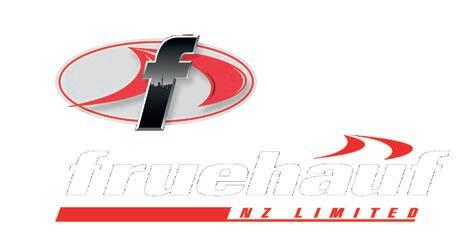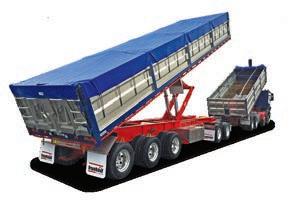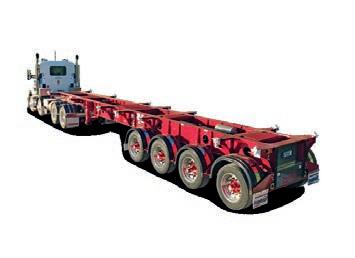
17 minute read
Highand Mighty
Big Test
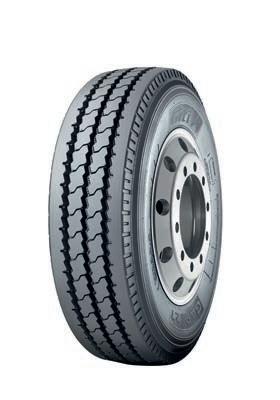
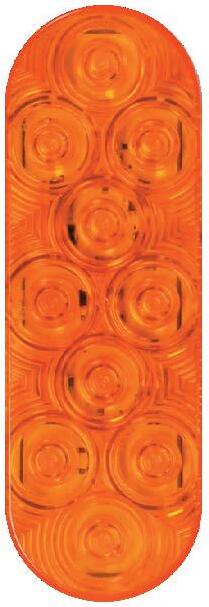
OR NORTH ISLANDERS IT’S BEEN THE BIG WET. Summer events have been cancelled, highways blocked and even washed away. City streets and buildings flooded.
The rain in the north pre-dates the soggy summertime headlines. Many parts of the country also had an unusually wet winter and forestry operations in some remote regions experienced significant difficulties in access and operation.
The new XT model Scania G 500 8x6s being introduced by Pacific Haulage Ltd in the Gisborne region are an effort to keep the wheels turning when the forest conditions become marginal.
In a joint venture between Pacific Haulage and three of the Eastland forest owners it works alongside, five of the new Scania’s began working in the PHL fleet last year with five more due in the second quarter of this year.
The concept is to use the new 8x6 units in the areas where road building and maintenance to suit the nine-axle loggers would be particularly expensive.
Based on Scania’s XT heavy duty construction models, the G 500s combine the 500hp (368kW) Euro5 version of the 13-litre Scania DC13 in-line six with a 14-speed manual transmission.
With drive sent not only to the rear axles but also to the front axle when required, the combo of six-wheel-drive and raised ground clearance provides a specialised skill set for demanding conditions.
PHL Group General Manager (Eastern) Campbell Gilmour says introducing the Scania’s alongside PHL’s signature Kenworth T659 fleet is adding versatility to the operation. When all 10 trucks are in service, they will be allocated to PF Olsen, JNL and Aratu Forests, with the ability to mix and match between three forest owners as conditions and workload require.
Campbell explains it’s the high cost of building and maintaining roads suitable for nine-axle 50MAX units that has prompted the introduction of the 8x6 Scania’s working on 48-tonne permits with four-axle trailers.
He says it gives forest owners the choice of leaving the marginal roads the way they are and using the Scania’s when the alternative is to spend more money on a road to keep the bigger trucks moving.
“The Scania is on the cusp of being an off-highway truck,” Campbell says.
“It has attributes of an off-highway truck and also a more standard truck. We work in steep country and there can be 20kms plus of offroad tracks after leaving the public roads to get into the skid sites.
“These days the cost of roading materials is through the roof. So, these trucks open up some new possibilities for the customers.”
It took some joint research and round table discussions between Pacific Haulage and the forest owners to give the Scania’s a green light. But both sides see the benefits.
In fact, both had been independently looking for new transport solutions.
“We were thinking about something and got to talking to the forest owners and their ideas kind of meshed together with ours,” says Campbell.
“It was a collaboration, and it was also a leap of faith. We were all thinking about it, but no-one wanted to pull the trigger and commit to it.
“In the end you can sit on your hands and procrastinate, or you can give it a go.
“We did a road trip over to Waimarino [near Raetihi] where McCarthy’s have some 8x6 Scania’s working with three-axle trailers.”
Campbell says the 8x6 units are already proving their worth and operating in conditions that would be difficult for larger trucks.
“Next winter is when I think they’ll really come into their own,” he says.
Offering the forest owners view on the new trucks is Shaun Truelock, regional manager East Coast Forests for Juken NZ Ltd (JNL). Shaun confirms the thinking behind bringing the Scania’s into the operation is primarily the cost of roading.
“It’s really escalated in the last five years along with increased compliance and things like that,” Shaun says.
“The main driver behind having a truck that can go on an increased gradient is the roading cost. The less roads we have, the less risks we have from a compliance and environmental point of view and the less we have to maintain them over the next 25 to 50 years.”
That is sound economics but there is another factor to consider.
“It’s balancing out the saving in reduced roading costs with the higher costs of the configuration and the type of truck. The truck carries about 11% less than the standard trucks we are using,” Shaun says.
Shaun’s background in logging has been in South Africa and Zambia and also in Australian mines. That experience has brought a different approach.
“It almost seems New Zealand’s forestry is stuck in one way of building roads and never considers alternatives,” he says.
“You don’t go over 12% grade and that’s what they’ve stuck with. This [the Scania 8x6s] gives you another tool in the toolbox.”
The Scania 8x6s can work on a 14% grade.
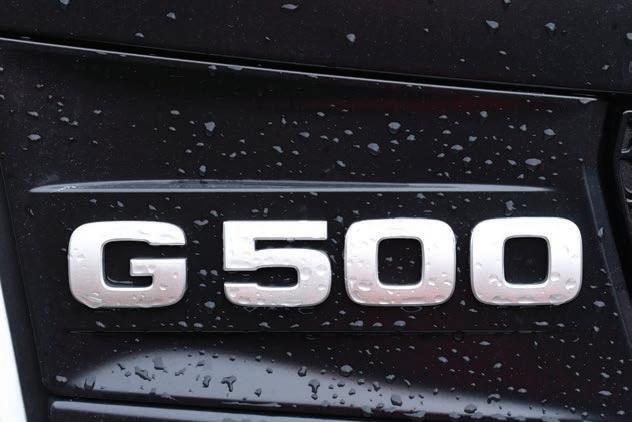

“We can go up and over some hills rather than build a road around them to maintain that [12%] grade,” Shaun says.
“I have come from a completely different forest environment. We didn’t build the roads all the way to the extraction machines . We would actually short haul and load from designated depots using a mix of offroad trucks and Moxy’s.
“The geology being so young here is really difficult. Normally we build a road, and the rock is all there but here we have to bring the rock in.
“That’s the biggest thing. There’s no blasting here. In South Africa you struggle to dig. Here you struggle to keep it where you built it. It keeps moving and it’s a lot softer.”
Shaun gives an example of where the Scania’s add versatility to the logging operations.
“Every now and again you’ll get a skid site that you are just about to finish logging. You might have 500 tonnes left on it and instead of spending another 20 grand on fixing the road, so the normal trucks can get in there and get out, we can phone Campbell and ask `hey can you send the 8x6s to this site and clean it out for us.
“So, when you start getting into sticky situations the 8x6s can get in and get out.
“It’s variable site to site but if you plan on standard trucks and then plan on the 8x6s the saving can be as much as 20% on the roading cost.
“The average cost of putting roads in where we are working is about $280,000 per kilometre. So, when you start reducing that by 20% it makes some massive impacts.
“It’s also the associated risk of having less roads so you are less exposed to weather events and stuff. Every metre of road you put in is an extra metre where you are exposed to environmental risk and the upkeep for the next 25 years or whatever.”
Campbell says the Scania solution doesn’t replace the Kenworth’s. And nor will it mean all new roads will be built steeper.
“There will be a balance to it . You wouldn’t want to build everything to that standard, it’s just when you get to that pinch point there is another option.”
The choice of the XT Scania G500 for the job was a fairly easy one.
“You could probably do the same sort of thing with a MercedesBenz or something else. But we have a relationship with Scania, and they’ve been good to us. Why try something new when you know the product and you know the people?”
“They are all Gisborne-based and all serviced locally under Scan Plan,” says Campbell.
Scania’s model line-up means the 500hp engine is the most powerful available in the XT range and by modern standards the output is on the lower side for a logger.
“Maybe if there was a bit more horsepower, we might see a small improvement in the fuel consumption,” says Campbell.
“We are averaging about 1.6km per litre but it’s early days and I expect that will get better. And Gisborne is a tough test.”
The G 500 on test in this issue is also the fourth truck in New Zealand – and the first in the PHL fleet – to be fitted with the Swedish developed ExTe Com90 hydraulic log restraint system.
It replaces chains with remotely operated arms that pull down on the logs with hydraulic pressure. Evans Engineering are the NZ agents for ExTe products and PHL50 works with Evans logging gear and four-axle trailer instead of the Patchell hardware that is typically fitted to PHL trucks.
“We are trialling the Com90 system. There’s a lot of focus on shoulder injuries and there’s definitely a benefit to driver wellbeing,” says Campbell.
For the NZ Truck & Driver Big Test we team up with driver Paul Rice in PHL 50.
It’s the fifth of the Scania XT’s to go on the road and our test is a 130km round trip from PHL into the Te Rata Forest to the northwest of Gisborne. Paul says it’ll be his first visit to a new skid site.
While the distances aren’t huge the terrain is demanding and a round trip can be 5-6 hours, meaning typically two loads a day.
We greet the G 500 8x6 parked among a few of its KW brethren and meet Paul who is getting ready for his eighth day out in the Scania having switched from a Kenworth T659.
We begin chatting about the layout of the cab and Paul is a fan of the generous headroom, the fridge and the handy drawers to stow his paperwork.
“All six mirrors are power adjustable, and I use the electrics on them quite a bit. There’s a driver attention camera and if I look away it will let me know.
Paul keeps his wet weather gear in one of the cabinets and his hard hat and gloves in another. And he’s enjoying the Scania comfort and its supportive driver’s seat.
“At the end of a week my hip was getting sore in the Kenworth. But I did a full week in this last week, and I felt great. It’s the all-round comfort and having everything accessible, right at your fingertips,” says Paul.
“It’s a very tidy set-up inside. It’s pretty comfortable, there are 15 buttons on the seat including a heater. Years ago, it was just one to slide back and forwards.
“I like the Kenworth’s and I’m not knocking them. This truck just has a different application,” says Paul.
Paul began driving trucks in 1987 on a Gisborne-Auckland run carting live crayfish.
He has lived in or near Gisborne much of this life, moving from Feilding when he was eight and living in the Eastland region apart from six years in Perth working in the mines. His only previous experience of Scania product was driving a bus during his time in the mines.
He joined Pacific Haulage about five-and-a-half years ago.
“It was my first time in logging, and it was my first experience with a Roadranger as well,” he says.
“I started in winter and thought `what the hell am I doing? It was kind of sink or swim, but I really enjoy it. Throwing chains doesn’t worry me.
“I love scenery out here and working in places very few people ever get to see. Where we are going there are wild horses and other wildlife. They [the horses] are in no hurry to get out of your way and
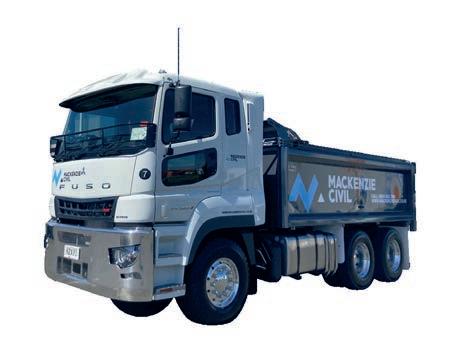
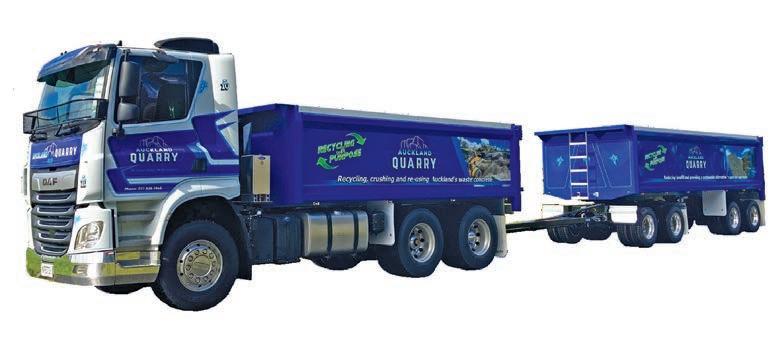

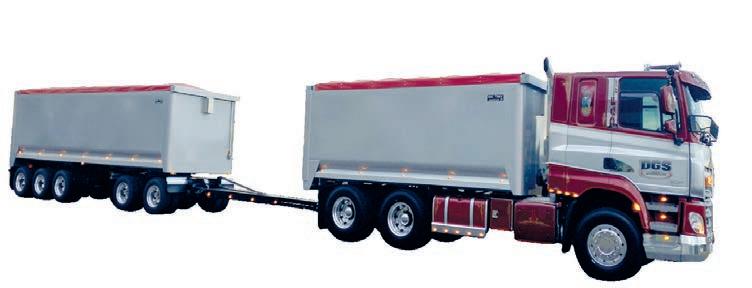


I’ve seen deer jumping down off the banks. The scenery is unreal, you can see Nicks Head on a clear day.”
The scenery comes with tough terrain and low average speeds.

“My day is normally two runs out of here. It’s roughly a 150km round trip so I’m doing about 300km for the day,” says Paul.
Paul agrees the winter has been wetter than usual and has his own benchmark to judge the recent weather patterns.
“It’s been wetter than normal. I’m a beekeeper and you notice the last three years the honey flow is down. There’s isn’t as much nectar because the flowers aren’t opening with the sun.”
Paul says he’s already had a taste of what the Scania will do.
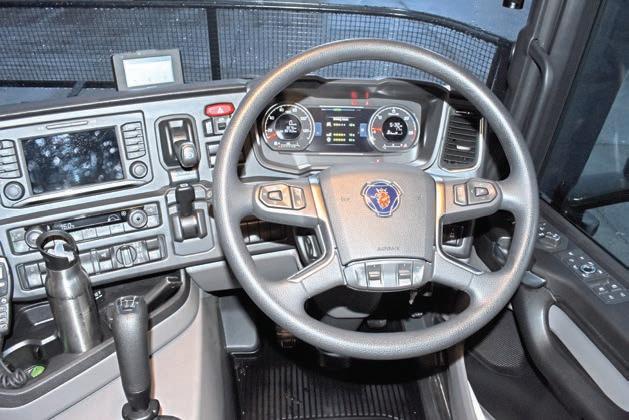
“It’s good. It’s come out of places with no problems where the Kenworth guys have only just got out of.
“I’ve been trying to get some of the other guys interested in it, but they reckon it’s low on horsepower. Once you know the gearing and get it moving it’s good.
“It’s also nice and quiet and the ride is beautiful. Sitting up high you’d think there would be quite a lot of bodyroll, but no.”
Paul explains our destination is a new one with a fresh road just pushed to a new skid site. And there’s been overnight rain in the area.
“I’ve heard the Western Stars aren’t getting out so it will be a test for this,” he says.
Our route takes us northwest from Gisborne on Highway 2 towards Te Karaka and on the open sections of the gradually climbing highway the Scania is in top gear cruising at 90kph and barely working at a relaxed 1300rpm.
The highway section of this trip is short. We turn right and head north on Whatatutu Rd heading into the Te Rata Forest. Even the public road section is a challenge with slips, steep climbs and descents, single lane sections and a shingle bed crossing of the Te Weraroa River.
Sitting higher than most of the other trucks on this section of road there’s a bit of pruning being done of overhanging branches and when we stop to regroup with our photographer there’s a little greenery attached to the Com90 arms.
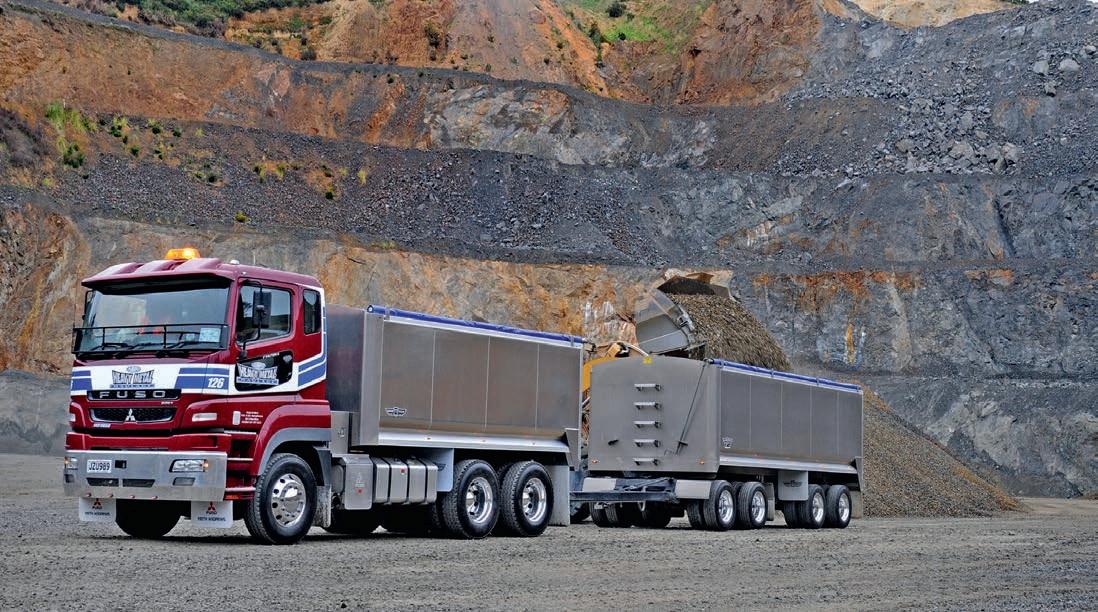
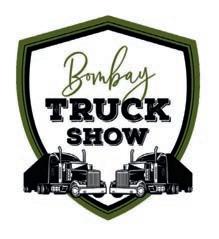

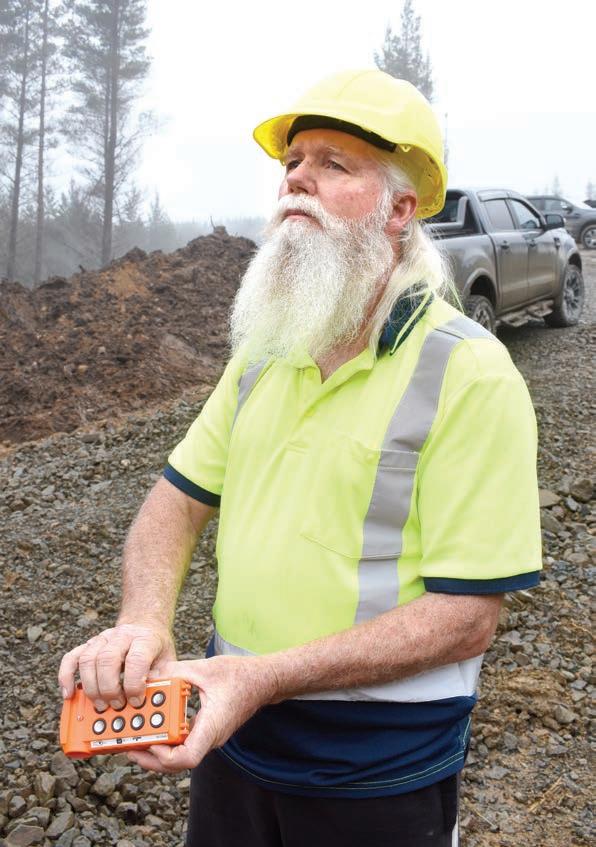

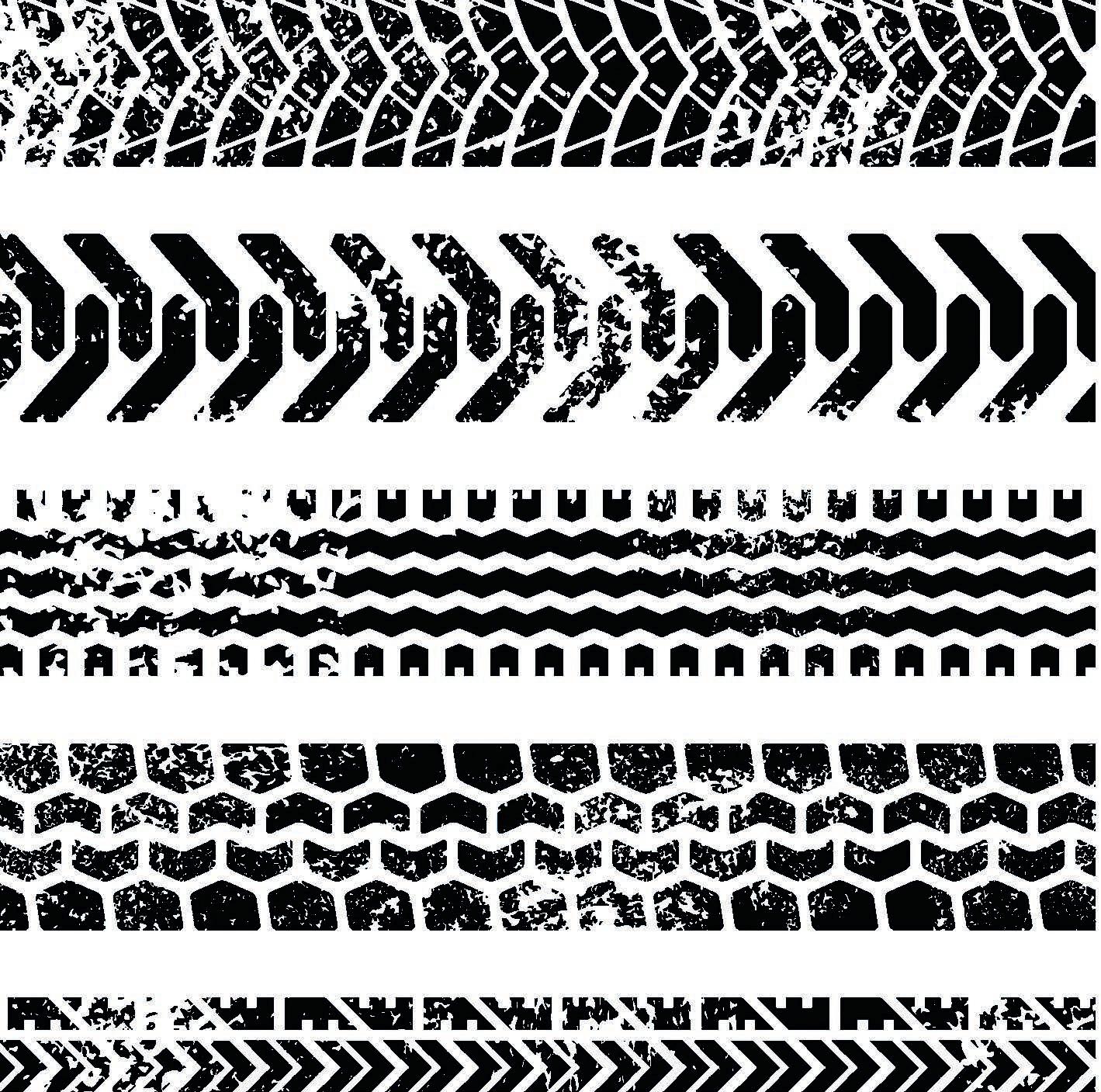
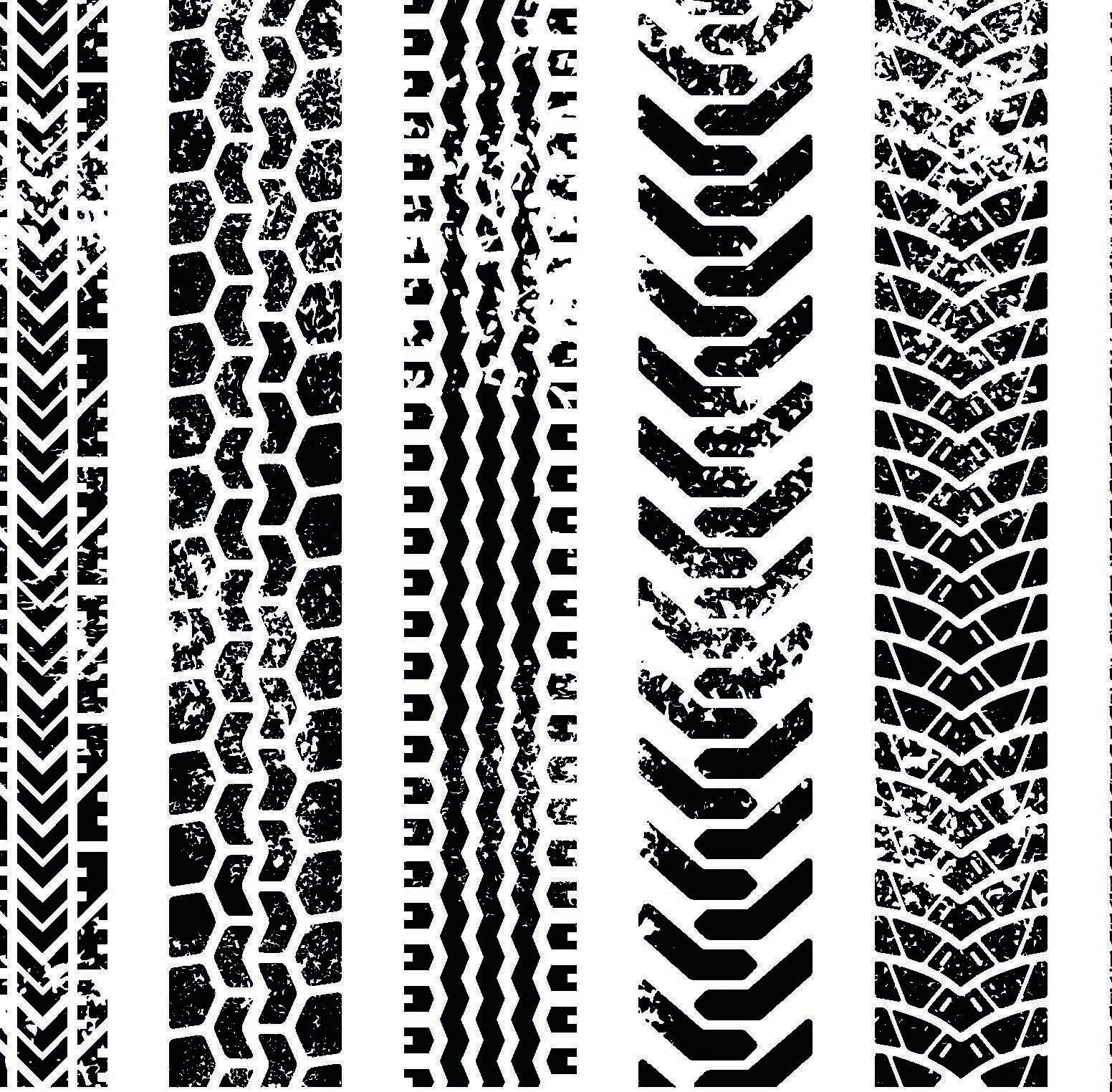
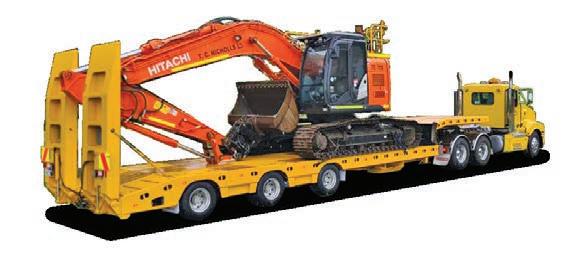

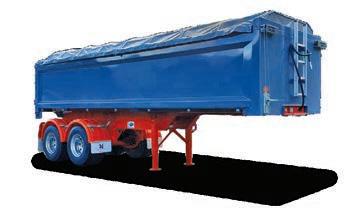
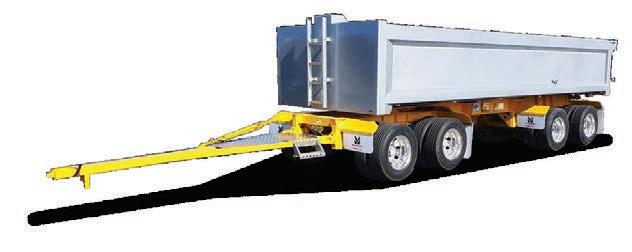
Turning through the forest gate most the access to the skid site is downhill. It’s slippery on the narrow track with a high crown in the road. Paul is careful on the descent while I notice there will be steep climbs and some tight hairpins on the way out.
Unloaded and heading downhill in 4H the Scania is using 14001500rpm and covering the ground at a careful 20-25kph depending
“We will come down nice and slowly in this condition,” says Paul. The skid site we are driving to has shifted from the last time Paul visited the area and there are a couple of new switchbacks to get
We pass what had been the previous skid site and move down to the new site. Paul says the Scania is easy to manouevre with a threepoint turn to back down to the loader where the trailer is lifted off.
“It’s a couple of turns in this one. It’d probably be a 10-point turn
Loading is a chance to see the Com90 system in action with Paul operating the remote control to open the arms. The load is 3.9m logs on the truck and 5.9m lengths on the trailer. We weigh up at 47.5t and Paul says a typical load splits the weights at 24-24.5t for the
“We have experimented with a few different scenarios, but I’m The logs need to be loaded high enough for the Com90 hydraulics
“I was told I was getting a Scania back in March and soon after that I learned this system [Com90] was coming. I was keen to give it
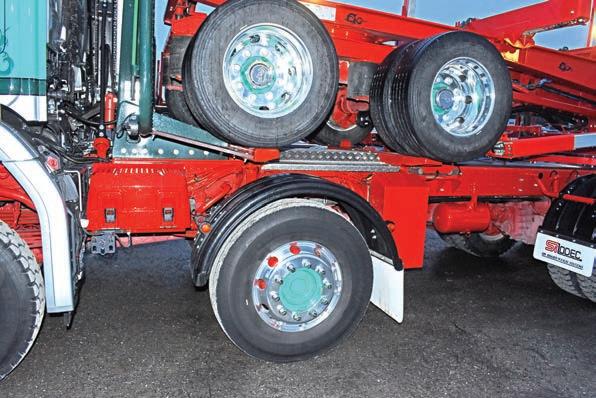
He says there are a couple more lines to hook up once the trailer is lifted off and Paul says a bit more care is needed in loading the
“Tyson [from the BRC logging crew] has already got the hang of loading it. If I go to any new sites, I will have to ask them to be

Having the Com90 system means one more display in the cab with a screen that advises any loss of tension on the load. It gives the cab a hi-tech feel along the display for the SI Lodec scales and

Paul laughs at the only issue he’s had with Com90 system.
“With chains I’d drive about 1.5 km and check them. Then I’d drive to another location and check them again and once more when I take my pre-advise photos before I hit the main tarseal road,” he
“But now I don’t have to stop so there’s been a couple of times I’ve arrived at the port, and I’ve forgotten to take my pre-advise photos.”
With the truck and trailer loaded at 47.5-tonnes it’s time for the acid test. There has been overnight rain to soften the new road and Paul is careful but keen to see how the Scania performs.
“This is one of the worst in terms of the pitch and a few switchbacks to get around,” he says.
“The Western Star’s aren’t getting out so it will be a test for this. I’ll keep it in low because it’s quite steep.”
The first section is uncharted territory. The fresh forest road is soft, and Paul has prompted the CTI to drop tyre pressures on the rear drive tyres to the offroad laden setting of 45psi.
The G 500 eases away from stationary and Paul leaves it in 1H with a steady amount of throttle holding just under 1500rpm. It’s a 7kph uphill crawl with no sense of slip.
“It’s a walk in the park,” says Paul as clear the newest section of what could loosely be described as a road.
“No wheelspin - nothing. I stayed in first to be safe and let it do its thing. I think it would have got out in second easily.”
We get around the next couple of switchbacks and Paul selects 2L and the speed rises to 8kph using 1350rpm. He’s not tempted to shift any higher just yet.
“It might flatten out and you’ll think you can go up the `box, but next thing you might have to go down again. I’d rather keep the revs low and just putt up. It might be slow but it’s safe.”
Soon the gradient eases a little more and we are using 3L at 11kph at 1350rpm.
“It’s probably fourth gear in the dry but it’s steep and slippery says Paul.”
Paul’s experience of the Scania’s capability in this terrain matches those of the other drivers.
“I think they’ve only had one stuck, but it was a really soft road.
They [the Scania 8x6s] went to a site where no one was getting out and they went in and cleaned all the logs out.
“I wouldn’t have got out of a new skid site like that in my old truck. Sometimes you need a little bit extra and that’s where the front-wheel-drive comes in to play.
“On those tight switchbacks the front-wheel-drive helps pull you around the corner where you might be sliding wide in an 8x4.”
The terrain undulates and while most the hard work from this skid site is a steep climb there are tricky downhill sections as well.
Paul likes the combination of retarder and exhaust brake operated from the right hand steering column stalk.
“If the hill is steep, it will hold me tight and then release slowly as the hill gives way. I used it the other day. It was holding me and then it started to release. Then I realised it was because the pitch had changed. That’s pretty clever.
“You can feel the retarder pulling on really nicely. You don’t use the service brake very much.”
On the highway Paul finds the cruise control holds the speed effectively and he’ll use its control to slow from 90kph zones into 70kph areas.
Paul says his learning curve on the Scania has been helped by modern technology and the internet.
“I found some good videos clips about the XT and Scania put out a good app. The guy who got the first one found out about the app and told me because he knew I was getting one. I’ve made use of that to find out little bits and pieces.”
For PHL and the forest owners the Scania 8x6s are looking like a timely new introduction adding a valuable degree of versatility to their operations.
And for Paul Rice, eight days in the Scania have been enough that he will be happy if it’s the last truck he drives.
“It’s only four years till I retire, and this will do for me till I retire,” he says. T&D
IT’S WELL KNOWN THAT IF YOU REALLY want to test a truck in the toughest conditions Gisborne is one of the best places in the country to go.
So, when we heard that Pacific Haulage Ltd had added Scania XT 8x6’s to its fleet our interest peaked. After a discussion with Campbell Gilmour from Pacific Haulage about the Scania’s new role in the fleet we could not wait to test these trucks.
Campbell explained that these trucks (10 in total with five at work so far) have been brought in to take on some of the most challenging forestry roads in the area and also help the forest owners with their roading programmes.
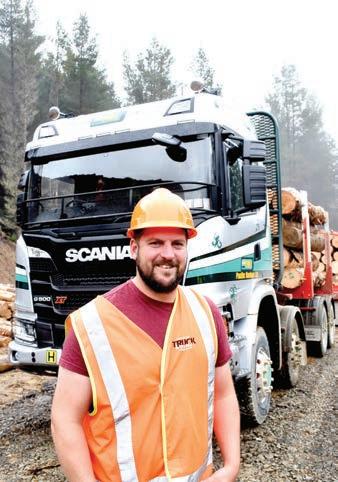
We catch up with the Pacific team at their impressive yard for our day out with the Scania where we meet regular driver Paul Rice. It’s been raining overnight and we are told the skid site we are going to is not the easiest and that some trucks have not been able to get out on their own.
The skid we are going to today takes us northwest from Gisborne on Highway 2 towards Te Karaka. We then turn right and head north on Whatatutu Rd heading into the Te Rata Forest. It’s a long run into the skid with most of the slippery public road looking like it’s a forestry road.
At the skid the truck is loaded to 47.5 tonnes and it’s time to see what this Scania XT 8x6 can do with its 500hp (368kW) Euro5 version of the 13-litre Scania DC13 in-line six-cylinder engine coupled with the 14-speed manual synchro transmission.
Paul pulls the truck up out of the skid in 1st high taking it extra easy on the steep and wet road with a few tight hairpins. Once onto the more established forestry road he opens the truck up and it’s not long until we are closer to the main highway, and I take over for my drive.
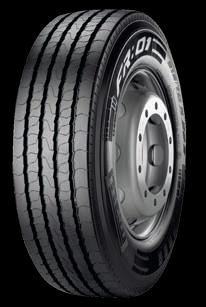
The Scania XT range is essentially their construction model, built for the toughest of roles the trucking sector can throw at a truck. But being a construction model truck doesn’t mean you lose all the Scania comfort and technology a lot of people have come to like about the European brand.
It looks tough with its high ground clearance but inside the cab it’s very similar to the on-highway trucks other than the manual transmission gear stick.
Once in the cab and comfortable I have to take a minute to memorise the gear shift patter which is easiest to explain as lower case h pattern. Once I am up and running the synchro box is smooth and easy to use. The only issue I have is coming down the gears, not being used to this pattern and the change from 3rd gear back across and down to 2nd is a little difficult until you get used to it. It does also make it difficult remembering not to double clutch…
The rest of the drive out to the public highway was uneventful with the truck handling the forestry road with ease and the comfort of the spacious Scania cab making everything seem easy. At one point on the way out on a hair pin turn another truck did not hear our radio call out and things got a little tight, but we managed to get around each other.
The retarder did more than enough holding me back on the hills, so I didn’t have to use the service brake all that often and the four-axle trailer tracked well around the tight bends.
Vision from the cab was very good, by being high up and with good mirrors road placement it was easy even to negotiate all the recent slips in the road.
All too soon my drive is over, and I have to hand the truck back to Paul. I have always liked the Scania comfort along with the other Euro brands and it’s nice to see the same qualities in a construction model truck.
As we went to print with this issue cyclone Gabrielle has just ripped through the region bringing more challenges to the area. I hope everyone down there is safe and well. T&D
Engine: Scania DC13 146 sixcylinder in-line, Euro 5
Capacity: 13.0 litres
Maximum Power: 368kW (500hp) at 1800rpm
Maximum Torque: 2550Nm (1880 lb-ft) at 1000-1300rpm

Fuel capacity: Diesel 390 litres, AdBlue 80 litres
Transmission: Scania GRSO905R 12-speed manual (+2 crawler) atios:
CL – 13.26
CH – 10.63
1stL – 9.15
1stH – 7.33
2ndL – 5.81
2ndH – 4.66
3rdL – 3.75
3rdH – 3.01
4thL – 2.44
4thH – 1.96
5thL – 1.55
5thH – 1.24
6thL – 1.00
6thH – 0.80
Reverse – 11.93:1
Final Drive ratio: 4.04:1
Front axle: Scania AMD600TZP + AM622T (18,000kg max)
Rear axles: Scania AD400TZP (21,000kg max)
Brakes: Drum with ABS/EBS
Auxiliary brakes: Scania R4100 retarder
Front suspension: Parabolic leaf spring with anti-roll bar
Rear suspension: Parabloic leaf spring with anti-roll bar
GVM: 39,000kg
GCM: 100,000kg
